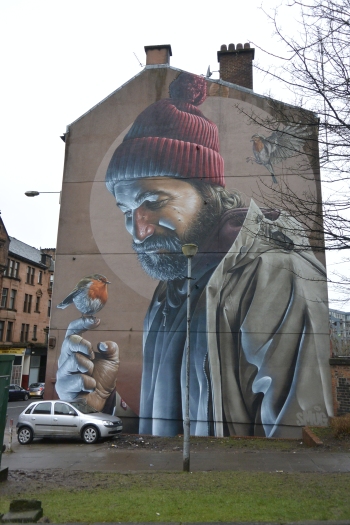Saints and sinners: a Glasgow urban walk

A couple of weeks ago, Facebook was full of a new Glasgow mural so at the first opportunity we went to see it for ourselves. The artist, known as Smug, has chosen his subject matter to match its location. It’s on a gable-end near St Mungo’s Cathedral, which is named after the city’s founder and patron saint, and represents a modern-day representation of one of his miracles, the bird that never flew. St Serf, St Mungo’s old master, tamed a robin which was accidentally killed by some of his disciples. They blamed Mungo who took the dead bird in his hands and prayed over it, restoring it to life. Look carefully, and you will see a halo round the modern Mungo’s head.
From the mural we crossed the road to the Cathedral and cut through the Necropolis. I was looking for a particular grave, that of William Minnoch, which I needed for another project. Successfully found!
From the Necropolis, we continued down to Duke Street and the Tennent’s Brewery. Now, I’m not saying people who drink beer are sinners – I’m more than partial to a pint myself – but it makes for a good post title. Mind you, some of the characters in the many murals which line the brewery walls look as though they might well be acquainted with a little bit of sin.
I’ve long meant to take a guided tour of the brewery but you need to book and, as I’ve never got round to it, we turned round and continued our circular walk. Plenty of interest as we headed back up towards the Cathedral.
For our final stop, we were back to saints. Provand’s Lordship is the oldest house in Glasgow – it was built in 1471 as the manse of the Master of the Chapel and Hospital of St Nicholas. After the Reformation, it had many secular uses before opening as a museum in the 1980s.
In one of the upstairs rooms, there was a collection of paintings of old Glasgow created in the early 1990s by Tom McGroran. I liked this one of Bridgeton Cross, a place I’m very familiar with, in the 1950s. For comparison, here it is today.
St Nicholas’s Garden, behind Provand’s Lordship, was laid out in the 1990s after the fashion of a 15th century physic or medicinal garden, so each bed has plants to treat different parts of the body, indicated by a moulding on the paving stones in front of it. The example below is for reproductive medicine.
The garden also features coats of arms, including Glasgow’s with the motto “Let Glasgow flourish” and the symbols of Mungo’s miracles (you’ll need to enlarge, I think, to see the bird that never flew perching in the tree that never grew!)
Around the cloisters are the Tontine Heads, so-called because they came from the old Tontine Hotel. There are 13 in total, varying in date from about 1737 to 1873. I’ve chosen two to display, because they reminded us of certain Scottish politicians. Anyone with knowledge of Scottish politics may wish to hazard a guess…
By this time, the weather was very wet and we hurried off to find a warm drink then get the Subway home. I hope you’ve enjoyed this stroll with some of Glasgow’s saints and sinners which I’m linking to Jo’s Monday Walks, Monday Murals and Art in the Streets.
































![Top-20-Travel-Blogs-200×150[1]](https://i0.wp.com/www.holiday365.co.uk/blog/wp-content/uploads/2012/06/Top-20-Travel-Blogs-200x1501.png)
I like the idea of the physic garden and its accompanying paving stones. I’m curious about which plants they felt had curative powers for which body parts.
Speaking of beer, your Colorado trip will have you leaving before Denver’s Great American Beer Festival Oct. 6 thru Oct. 8. It’s already sold out anyway. The tickets sell out in a matter of minutes. Coloradans love their craft beer.
LikeLike
I’m sure we will still be able to sample some on our way round!
LikeLike
Have never been to Provand’s L so found this interesting.
Posted a poem about St Mungo and the robin about 3 posts ago….
LikeLike
Found it! Provand’s Lordship is definitely worth visiting.
LikeLiked by 1 person
Will try to visit next time I am gallivanting up north!
LikeLiked by 1 person